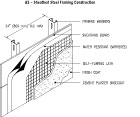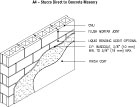
That is a complicated question and looking at the code and referring to thickness tables provides even more confusion. In addition, many consultants and experts in the litigation field try to make it simple and absolute in an attempt to crucify the plastering contractor. This is not to say all plastering contractors apply plaster at the correct intended thickness. Some plastering contractors cheat and should be brought to the carpet. However, many plastering contractors are good people doing what is intended by the code and then are held to an impossibly unrealistic and misunderstood standard. I have often seen samples removed from a wall, then measured by forensic experts with calipers to see if the thickness violates the code. Not surprising to me, it almost always is in non-conformance. I can promise you if you take enough samples of stucco from a wall-no matterhow good the application-it can be proven to violate the code. Why? I will explain and I will also provide a more fair and honest method to measure true plaster thickness.
The code seems confusing, as it calls for all Portland cement plaster to be anywhere from 3/8-inch to 7/8-inch finished thickness per IBC, ASTM C 926 and IRC Table R702.1. And then, from where do you measure the thickness? The code is all over the place, the back plane of the lath, the face of the support or backing. Here are the basic simple rules to follow to be code and industry compliant.

CONCRETE OR MASONRY
First and foremost, the substrate is recommended to be at a tolerance of 1/4-inch in 10 feet. Anything that exceeds that tolerance will force the plastering contractor to apply plaster to a thickness that may violate code. Wall and ceiling contractors should be aware of this and supply letters to protect themselves prior to proceeding with the application of plaster. Plaster over concrete or masonry is referred to as a maximum thickness. Without lath, the maximum is 5/8-inch for walls and 1/8-inch for ceilings. Plaster may be applied thicker, if lath is used.




Report Abusive Comment